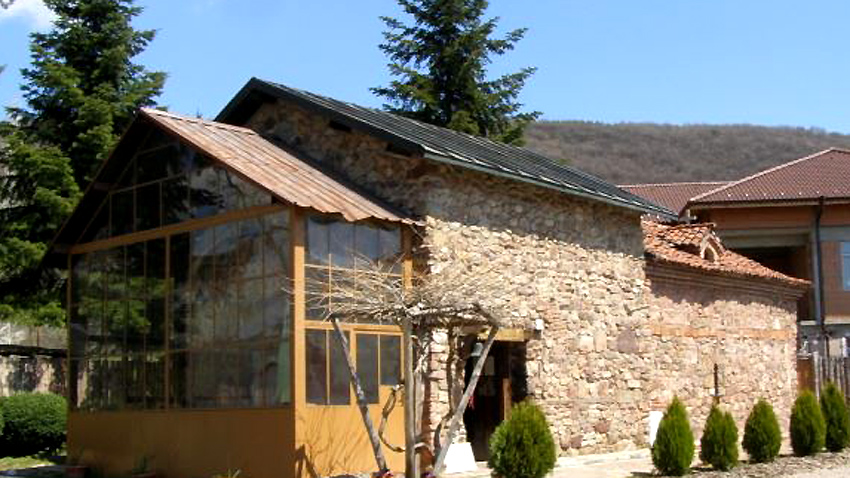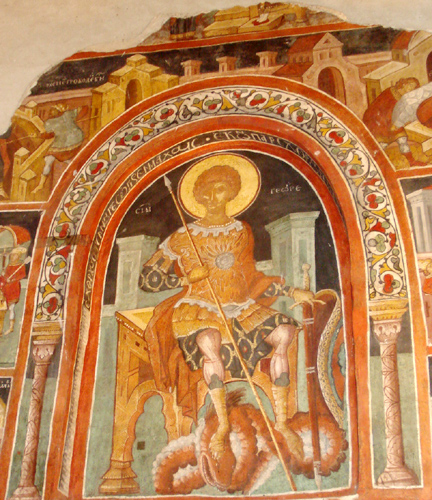The Holy Martyr, St. George the Victor is one of the most revered Bulgarian saints. According to his passional, he was born in the 3rd century to a Christian family. He was famed for his wits, his prowess and his physical strength. Once he started his military service he quickly became a favourite with Emperor Diocletian. And when the persecutions of Christians began he gave his worldly belongings away to the poor and proclaimed he was a Christian. George was arrested and tortured but never relinquished his faith, so he was sentenced to death. The day of St. George, patron saint of soldiers, farmers and stockbreeders is marked on May 6.
 In Christian Orthodox tradition St. George is depicted in two ways – either on horseback slaying a dragon, or only his face is depicted. But in the St. George the Victor church at Kremikovtsi monastery near Sofia there are three unique frescoes of him which do not follow iconographic canon. The restoration of the frescoes dating back to the 15th and 16th century spanned almost 13 years. Thanks to the magnificent job done by architect Stoyan Yanev and the teams of Lyuba Kraskova and Zamphir Petrov, the frescoes can now be seen in all of their splendor.
In Christian Orthodox tradition St. George is depicted in two ways – either on horseback slaying a dragon, or only his face is depicted. But in the St. George the Victor church at Kremikovtsi monastery near Sofia there are three unique frescoes of him which do not follow iconographic canon. The restoration of the frescoes dating back to the 15th and 16th century spanned almost 13 years. Thanks to the magnificent job done by architect Stoyan Yanev and the teams of Lyuba Kraskova and Zamphir Petrov, the frescoes can now be seen in all of their splendor.
“They have been restored, the degradation has been halted and they have been conserved.” says iconographer Kristian Spiridonov. “The frescoes are very beautiful, made by genuine master icon painters.”
 The difference in style and method of work shows that the walls were pained at different times. The figures of saints stand out vividly against a somber background. Right across from the door is St. George on horseback. If you look carefully you will see that in the saddle next to him there is a boy. In fact this fresco depicts one of the miracles the saint worked in the Bulgarian lands.
The difference in style and method of work shows that the walls were pained at different times. The figures of saints stand out vividly against a somber background. Right across from the door is St. George on horseback. If you look carefully you will see that in the saddle next to him there is a boy. In fact this fresco depicts one of the miracles the saint worked in the Bulgarian lands.
“This child was abducted by the invaders, sold into slavery to wait at the table of an eminent noble. His parents asked St. George to help bring the boy back. The saint heard their prayers and grabbed the child right from the table, along with the jug he was holding and took him back to his parents,” Kristian Spiridonov says.
Another interesting thing is the strange posture St. George has assumed while he is slaying the dragon. By a tradition, the saint is depicted as aiming a downward blow with his lance. But here he is dealing a level stab, holding the lance under his arm. This is the customary way knights in Western Europe used the lance so there are very few such depictions in the Balkans.
The second fresco depicting St. George is in one of the niches in Kremikovtsi church. “It is a splendid icon, the face is very realistic and unlike the other fresco, it is very well preserved. Usually St. George is looking to the right,” Kristian Spiridonov goes on to say. But in this mural the horse rider has his head turned to the left, facing us and he is dealing the blow with his right hand. His armour and sword are also fascinating – they are not to be seen in practically any other depiction of St. George. Even though according to legend after piercing the dragon with his lance, he beheads it with a  sword. The horseman is holding a shield, an attribute he is rarely depicted with. The composition itself is unusual and most of all the positioning of the dragon which is not in the forefront and to the side of the rider, but under the hind legs of the horse.
sword. The horseman is holding a shield, an attribute he is rarely depicted with. The composition itself is unusual and most of all the positioning of the dragon which is not in the forefront and to the side of the rider, but under the hind legs of the horse.
In Orthodox art, it is very rare to see saints sitting on a throne. Yet in the Kremikovtsi monastery church there is a fresco showing St. George on a throne, the only one of its kind. The saint is in military attire against a golden background. In his right hand he is holding a lance and in his left – a sword, hilt up, his feet on the body of the slain dragon.
“It is rare to see such a St. George on a throne. Around the central figure there are passional scenes showing how he was tortured so he would give up his faith. But he held firm,” Kristian Spiridonov explains.
For its magnificent and invaluable frescoes, the St. George the Victor church at Kremikovtsi monastery has been proclaimed a monument of culture.
English version: Milena Daynova
Photos: Desislava IvanovaIt is 131 years since the birth of Tsar Boris III, dubbed unifier. Boris Saxe-Coburg-Gotha found himself at the head of Bulgaria after the abdication of Tsar Ferdinand after the defeat of the country in World War I. The young monarch was crowned..
The ancient city Heraclea Sintica is among Bulgaria's most attractive tourist sites presented at international tourist exhibitions in Vienna and Stuttgart , Katya Stoyanova, head of the project "Restoration, conservation and socialization of Heraclea..
Archaeological excavations in the Kaleto district of the Bulgarian town of Lom situated on the Danube River have revealed remains of Roman defensive facilities dating back to the 1st century AD . Archaeologists prove that Lower Danube region..
Bulgarian Patriarch Daniil will celebrate the first liturgy in London for the consecration of the new church of the Bulgarian Orthodox community in the..

+359 2 9336 661
